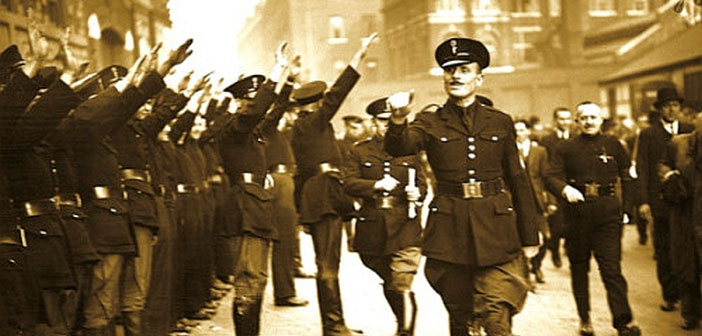With racism and Islamophobia on the rise across London and the UK, it seems the tensions and dangers of 1936 still echo today.
Source: Al Jazeera
Uncertain, turbulent times: the far-right on the rise in a fractured, fearful Europe and in Britain, a chilling wave of xenophobia and attacks on immigrants and refugees.The circumstances may strike a chord with us today. But this was London at the height of the Great Depression, when gangs of black-shirted fascists brought fear and violence to immigrant communities, and one violent, dramatic day of barricades and riots would become mythologised as the Battle of Cable Street.
On October 4, 1936, the charismatic leader of the British Union of Fascists (BUF), Sir Oswald Mosley, set out to march 5,000 of his uniformed Blackshirts from the Tower of London to the heart of the immigrant communities of the East End. In the mid-1930s, the borough was mostly Irish and Jewish [PDF]. Today, it is home to London’s largest Muslim community.
It was to be a triumphant march for Mosley and his fascist legions. The aristocratic former Member of Parliament would march through London and then fly straight to Berlin to marry the famous socialite (and fervent Nazi) Diana Mitford. Their wedding would be at the home of Nazi propaganda minister Joseph Goebbels, with Adolf Hitler as the guest of honour.
Max Levitas, now 101 years old and still living close to Cable Street, was there on October 4, 1936, with his brother and father. They stood with tens of thousands of Londoners packed into the narrow streets of the East End, waiting behind police lines and improvised barricades.
Eighty years on and sitting in his modest home on nearby Sidney Street, Max recalls one of the most dramatic yet often overlooked days in 20th century British history.
“We had to stop Mosley and his fascists. We had to ensure these racists could not terrorise the people and march through the East End,” says Max.
“There were huge crowds. Everybody was shouting: ‘C’mon lads, we’re going to go out and stop them. They want to march – we’re not going to let them.’ We stood together; we fought back,” he recalls.
A fight against European fascism
In 1936, fascism was on the ascendency in Europe. Civil war had just broken out in Spain. In Britain, the Daily Mail newspaper, whose proprietor Lord Rothermere was an early admirer of Italy’s Benito Mussolini and Hitler, had carried a front-page headline proclaiming, “Hurrah for the Blackshirts”.
The Daily Mail editorial, written in 1934 by Lord Rothermere himself, eulogised Mosley and his fascist movement of some 40,000 men as the powerful alternative to the weak democrats who had failed in the face of the Great Depression, stating: “The new age requires new methods and new men.”
Rothermere’s admiration for the BUF cooled as they got involved in violence and civil unrest. On that October day, 80 years ago, Mosley’s BUF was still on the fringe of British politics. But fear and paranoia were in the air.
Posters pasted to walls all over London proclaimed the march through the “Jew-ridden and communistic” streets of Stepney and Whitechapel. The Blackshirts had already brought violence and intimidation to the narrow dockside streets, crowded with immigrant Irish dock workers, who had fled poverty and famine in their native land, and a huge Jewish population, recent refugees from the Tsarist pogroms and upheaval in Eastern Europe.
On the day of the march, the response was the mobilisation of the immigrant communities of the East End, together with British trade unionists and leftists, to stand against Mosley with barricades, bottles, bricks and fists. Figures for the crowds who opposed the Blackshirts vary dramatically, but historians agree that it was in the many tens of thousands.
“Irish dockers, Christians, Jews, socialists, union men, communists. We all joined together to fight,” says Max.
Mosley had official permission to stage his demonstration. But the thousands of policemen, including many on horseback, swinging batons as they charged the crowds, could not force a path through the barricaded streets.
And in what has been celebrated as a rare, if not unique, victory against European fascism before the Second World War, the people of the East End stopped the British Blackshirts in their tracks, forcing Mosley – who had been giving the Nazi salute from his open-topped Rolls-Royce limousine – to beat an ignominious retreat.
‘A myth partly based on reality’
The 80th anniversary of the Battle of Cable Street will be marked with a series of events this October, and the streets in which the clashes took place are today marked with many commemorative plaques and signs as well as one of London’s biggest street murals.
However, while it remains a shining moment for the British Left, some, such as Daniel Tilles, a historian and specialist on British fascism in the 1930s, believe the events have been mythologised over time.
“There is a myth but it is partly based on reality,” says Tilles.
“On the day itself, it was a great victory for the anti-fascists, who greatly outnumbered the Blackshirts and stopped them from marching through the East End of London.
“But Mosley’s deliberate aim had been to provoke counter-violence to what was a lawful demonstration. In a way, he got exactly what he wanted. It allowed him to portray what happened as immigrants, aliens, violent communists stopping British citizens from exercising their lawful right to demonstrate.
“In the months after Cable Street, British Jews suffered far greater violence, intimidation and abuse than they had beforehand, So Cable Street unleashed this wave of anti-Jewish violence and abuse and gave the fascists a boost in popularity.”
Tilles says that those who opposed the fascists in Britain learned important lessons from Cable Street: that it was better to organise politically, to infiltrate the far-right groups, gather intelligence and deny them the “sense of victimhood” that came with confronting their actions with counter-violence.
“Just like Mosley in his day, the far-right today thrive off that sort of conflict; it gives them media attention, it helps them to sustain this victimhood narrative, and when it’s ethnic minorities, Jews in the 30s or Muslim communities today, violence helps them to reinforce that narrative and the prejudices these groups want to exploit and spread,” he adds.
Fiyaz Mughal is the founder and director of Faith Matters, a charity which works for interfaith understanding and against radicalism in Britain and in countries including Pakistan, Egypt and Syria.
Mughal also believes that Cable Street has important lessons for those combating racism and radicalisation today.
“I’ve been involved in anti-racism for 15 years or more, but I’ve been aware of Cable Street from a young age. It has always resonated with me, as a person who is of a minority who came to the UK,” he says.
Mughal has recently set up Tell MAMA UK – a social-media based service which records and highlights racist incidents. And he says he has seen a “very sharp spike” in hate crimes, intimidation and abuse based on religion and ethnicity since the Brexit vote.
“It is impacting greatly on Muslim communities such as those in the East End. And the main type of Islamophobia reported there are comments made from passing cars to Muslim women. We have also had far-right groups such as Britain First demonstrating there,” he says.
“The level of fear within Muslim communities has risen rapidly. Those being targeted most are Muslim women, because the way they dress makes them visible. It is causing fear and resentment. You have today, as you did in the 1930s in the same area, different communities becoming isolated, becoming fearful.
“And when people are isolated and fearful, when they believe they are being victimised, there is the danger of some becoming more open to the message of those who want to radicalise.”
Mughal believes that there are important lessons to be learned from the violence in the East End in the 1930s.
“They are pretty clear. We have given, as a society, extremist groups the opportunity to promote hatred and intolerance,” he says.
“Cable Street shows us that we cannot stand by. We must work extremely hard, be proactive, use intelligence gathering, outreach into communities, devote resources and support for those being targeted, to combat extremism on all sides.
“What the events of 1936 did was rouse people and ensure that they focused on using many ways to isolate and fragment the far-right. We must do the same with all extremist groups who would threaten us today.”
For the British fascists of the 1930s and those who opposed them, Cable Street was in many ways the high-water-mark of street violence and confrontation. Oswald Mosley did get married in Berlin, but was jailed at the start of World War II and faded into obscurity afterwards.
The Irish and Jewish communities mostly left the East End in the post-war era, to be replaced by new immigrant communities, from Bangladesh, Pakistan, Somalia and the Far East. The streets themselves are also changing quickly today as gentrification takes hold.
However, with racism and Islamophobia on the rise across London and the UK, it seems the tensions and dangers of 1936 still echo through the decades.

